How Did The Emancipation Proclamation Change The Nature Of The Civil War Quizlet
The American Civil War was fought from April 12, 1861 to May 9, 1865 between the Union forces and the 11 Southern states that seceded from the Union and formed the Amalgamated States of America. Ultimately won by the Marriage forces, information technology remains the deadliest battle for the country with estimated deaths between 600,000 and 800,000. The Civil State of war is one of the about of import events in the history of the United states. It had many important repercussions which went on to have a deep and long lasting affect on the nation. Amidst these were the Emancipation Announcement; the Assassination of President Lincoln; the Reconstruction of Southern America; and the Jim Crow Laws. Know more about the bear upon of the American Ceremonious War through its 10 major effects on the Due north and the South, on slavery, on politics, on economy and on society.
#i Emancipation Proclamation
Although Abraham Lincoln considered slavery as an abhorrent evil, equally a lawyer and a politico he knew that the constitution protected slavery in united states where the citizens seemed to want it. In his beginning inaugural address, Lincoln alleged that he had "no purpose, directly or indirectly, to interfere with slavery in u.s.a. where it exists". With his election as president, the S ecession C risis and the Civil State of war, the political scenario began to change. After a series of victories in the early 1862, the Marriage suffered some demoralizing defeats. The big slave population of the south, though non involved in direct activeness, were helping the southerners in various other ways. The argument that emancipation was a military necessity was gaining footing. In mid-1862, Lincoln decided on the Emancipation Proclamation calling his cabinet for discussion. However, Lincoln's Secretary of State William H. Seward persuaded him to withhold the declaration equally the Union armies were beingness defeated. Seward argued that the sudden move would await like an human action of agony.
On September 17, 1862 the Union forces forced the Confederates to retreat at the Boxing of Antietam. A tactical and moral victory for the Northward rather than a military one. Five days afterwards on 22nd September, 1862 Lincoln issued a preliminary warning that he would social club the emancipation of all slaves in any state that did not end its rebellion confronting the Spousal relationship past January 1, 1863. The annunciation came into consequence on the celebrated day of January one, 1863 legally freeing 3.i million of the nation'southward 4 million slaves. It is noteworthy that the new law did not costless slaves beingness held in the border states of Delaware, Maryland, Kentucky and Missouri. Lincoln was concerned that the issuance of a universal emancipation of all slaves would persuade th east se states to secede from the Spousal relationship and join the Confederacy.
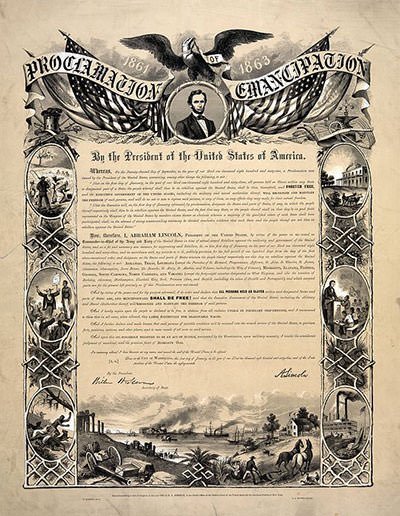
#2 Partition of Virginia
On April 17, 1861, the Richmond convention of Virginia voted on the Ordinance of Secession to secede from the Union. Simply many delegates hailing from the western counties of Virginia were opposed to the idea. Near immediately later on the adoption of the ordinance, a meeting of such delegates expect identify at Clarksburg recommending that each canton in north western Virginia ship delegates to a convention to run into in Wheeling. This led to iii conventions at Wheeling in May, June and July of 1861 and formation of the "Restored Government of Virginia" which gave legitimacy to the germination of ane state inside another. This meant that there was a bespeak when there were ii governments claiming to represent all of Virginia, 1 owing allegiance to the U.s.a. and ane to the Confederacy. The politics continued for the next few months. Finally President Lincoln approved the formation of W Virginia in 1862 which officially became a state on June 20, 1863, the merely state to course by seceding from a Confederate land.
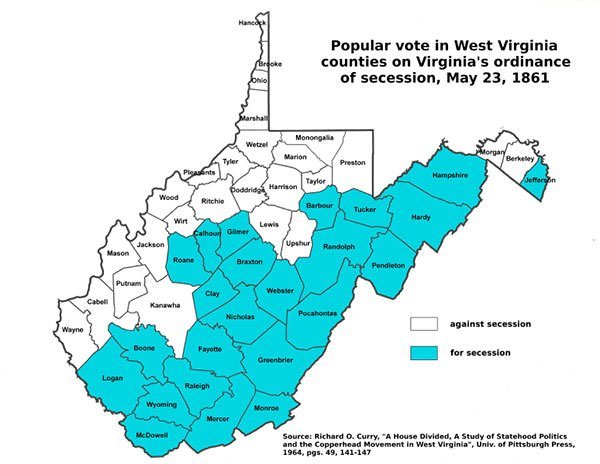
#iii Biggest loss of life in U.S. history
The American Civil War remains the deadliest battle for the country with estimated deaths between 600,000 and 800,000. The state of war claimed shut to 50 per centum more American lives than World War 2, and v to half dozen times more lives than World War 1. The Boxing of Gettysburg was the bloodiest of all challenge close to 50,000 casualties followed past Chickamauga and Spotsylvania. Diseases, infections and injury were the giant killers. Wounded soldiers were housed in overfilled hospitals with filthy atmospheric condition. The worst injuries were caused past the Minni Brawl rifle bullets of British Enfield and American Springfield rifles, which were used extensively in the state of war. Conditions were deplorable i n Matrimony and Confederate prisons, where prisoners ofttimes died from outright neglect or starvation. At the infamous Campsite Sumter prison camp in Georgia, prisoners were described every bit "walking skeletons". The Camp Sumter prison claimed the life of shut to a fourth of its 45,000 prisoners.

#iv Constitutional Amendments and alter in definition of American Citizenship
In the five years immediately following the Civil War the United States constitution adopted the 13th, 14th and the 15th Ramble amendments between 1865 and 1870. These amendments were added more than lx years after the twelfth subpoena of 1804 and primarily dealt with the issue of African Americans, people of color and slavery. The amendments are too called the Reconstruction Amendments as they were important in the reconstruction of South ern America afterward the Civil War.
The Thirteenth Amendment to the United States Constitution officially abolished slavery and involuntary servitude, except as punishment for a law-breaking. The Usa senate passed information technology on eighth April, 1864 and it was incorporated into the federal constitution on 18th December, 1865.
The Fourteenth Amendment was bitterly contested especially past the Southern States. Added to the Federal Constitution on July 20, 1868, the subpoena alleged that all persons built-in or naturalized in the United States are American citizens including African Americans.
The Fifteenth Amendment prohibited the federal and state governments from denying a citizen the right to vote based on that citizen'due south "race, colour, or previous condition of servitude". It was ratified and added to the Federal Constitution on February 3, 1870.
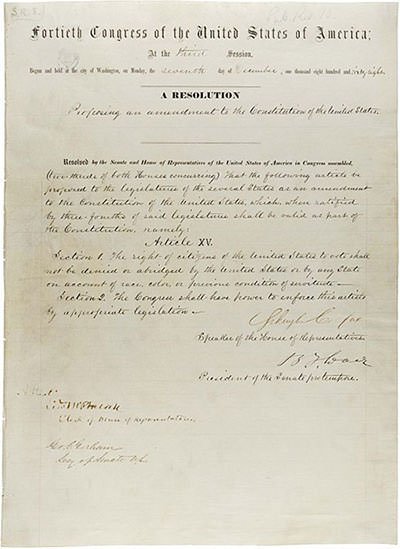
#five Bump-off of Abraham Lincoln
Afterward the surrender of Robert E Lee to Ulysses Grant at Appomattox Courtroom on 9th April, 1865, the Civil War was at its dusk. John Wilkes Berth was a native of Maryland who had remained in the North during the Civil State of war. He was a prominent stage actor and Amalgamated sympathizer who viewed Abraham Lincoln as a tyrant. With his initial plan of abducting Abraham Lincoln declining on 20th March 1865 and Confederate General Lee surrendering a few weeks later, Berth go desperate. Learning that Lincoln was to nourish Laura Keene'south acclaimed performance of "Our American Cousin" at Ford'due south Theatre in Washington, D.C. he hatched a sinister programme to impale 3 prominent Union leaders and throw the authorities into disarray. At x:15 pm on the 14th of April 1885, John Wilkes Berth slipped into the box where Lincoln was seated and fired his .44-quotient single-shot derringer pistol into the back of Lincoln'due south head. He then escaped after jumping on the stage. The other acts of the plot failed equally Lewis Powell failed to kill Secretary of State William H. Seward and George Atzerodt failed to assail V water ice P resident Andrew Johnson. Unwilling to surrender, Berth was shot dead on 26th April. His co-conspirators were convicted for their part in the assassination and executed by hanging on July 7, 1865.
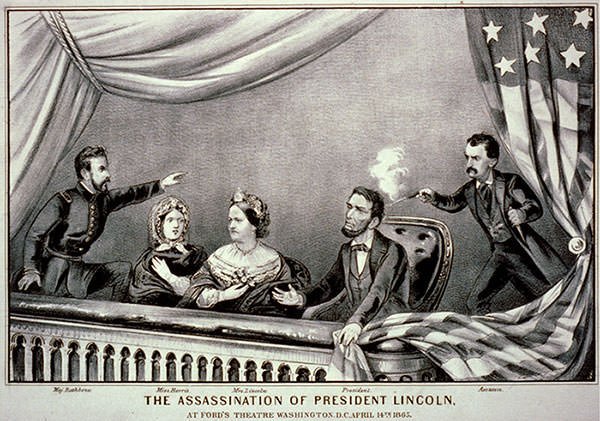
#6 Reconstruction Acts of 1867-68
Afterward the stop of the civil state of war at that place were many debates near how the former Amalgamated states would re-join the Union. In a way, there was an try at the transformation of the 11 Amalgamated States that had seceded from the Union. Abraham Lincoln had proposed lenient Reconstruction policies and, after his assassination, new president Andrew Jackson intended to follow the same principle. But the more radical Republicans and powerful anti-slavery groups were committed to equal rights for freed blacks and favored more stringent action. It was these groups that were majorly responsible for crafting the Reconstruction Acts. The offset neb divided 10 rebel states into five military districts for governance and they were required to typhoon new constitutions that would be canonical past the U.s.a. Congress. Three more acts were passed in 1867-68 which were concerned well-nigh how the new constitutions would exist created and passed at the state level.
#7 The Politics and Violence of Reconstruction Era
The Reconstruction Era refers to the flow immediately following the American Civil War from 1865 (the finish of the Confederacy) to 1877. The south was in disarray after the war and was all the same non part of the Union. Many bills and laws were passed during the reconstruction era with the aim of reintegrating the South into the Federal construction. The Republican Political party gained in prominence and the flow inverse the southern society and culture in many ways. Among other things, there was a ascent of violence and riots confronting the black communities and germination of many racist groups like the Cherry Shirts in Mississippi and the Carolinas, and the White League in Louisiana. Well-nigh of the violence was still carried out by members of the Ku Klux Klan (KKK), a secretive terrorist arrangement closely allied with the southern Democratic Party.
The 1866 Election gave the Republicans majority in Congress and enabled them to pass the 14th Subpoena, upgrad ing the rights of African Americans and curtail ing the powers of ex-confederates. Civil war veteran and radical republican Ulysses South Grant was elected equally President in 1868. He strengthened Washington's legal capabilities to directly intervene to protect citizenship rights of African Americans and crushed any acts of violence against them. Still, in the 1876 presidential election, Republican nominee Rutherford Hayes negotiated with southern political leaders to get elected. The federal troops returned in 1877 marking ing the end of the Reconstruction Era.
In the coming years new racial systems would disenfranchise black voters and they would remain tied to low wage employment in agriculture and households. Thus Reconstruction is generally viewed equally a failure. Nonetheless, the seed of the Reconstruction Era would remain planted in the constitution bearing fruit over close to 100 years later on in the C ivil R ights Chiliad ovement, sometimes besides chosen the " Due south econd Reconstruction".

#viii Scalawags and Carpetbaggers
The defeat of the South led to the breakdown of its economic, social and political state of affairs equally was known earlier the war. Most Confederate war machine and political leaders were temporarily prohibited from participating in the political process which led to the cosmos of a vacuum. This further led to the emergence of two groups that were called Scalawags and Carpetbaggers in a derogatory sense. Scalawags, which meant worthless livestock, referred to native white Southerners who supported the federal reconstruction program and cooperated with the blacks. The majority of them were modest non slave-holding farmers, merchants and other professionals who had remained loyal to the Union during the civil war. Although viewed as traitors in the Due south, the Scalawags fabricated upward close to xx percentage of the white electorate and wielded considerable influence especially after the ceremonious state of war. The term Carpetbagger referred to a poor traveler who arrives with only a carpetbag and slowly fills upward his purse by exploiting his surrounding weather. The term was used to describe the white Northerners who, motivated by profit or idealism , moved to the south after the Civil War. Many carpetbaggers were from the educated centre course of various walks of life. They saw themselves as reformers and wanted to shape the mail state of war South in the image of the Due north. Carpetbaggers were hated by the southerners as depression-grade and opportunistic newcomers seeking to go rich on their misfortune.
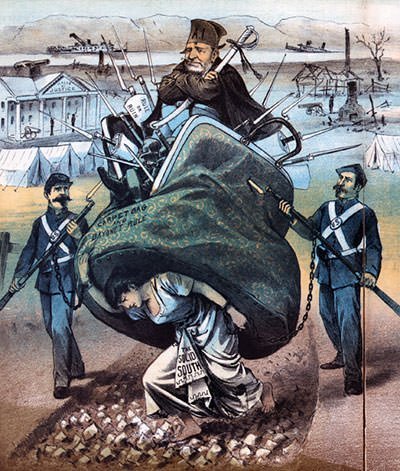
#ix The Jim Crow Laws
Subsequently the end of the reconstruction period in 1877, as the white southerners began gaining ability once again, methods were adult to featherbed the Reconstruction laws and subjugate the blackness people. The people who did this called themselves Redeemers. They aimed at taking away the civil rights of the blacks by twisting existing laws and bringing in new ones. The laws came to be known as Jim Crow Laws, named after a racist cartoon strip of a poor uneducated black human. The laws ranged from existence inhuman like forcing blackness people to sit down in the dorsum of public buses to insane such as a requiring black people to "authorize" to vote by paying poll taxes, or, past reciting the entire Declaration of Independence or Constitution from memory or the one where official records of black births, marriages, and deaths c ould non be kept in the same books that incorporate ed records of white births, marriages, and deaths. The Jim Crow Laws continued to exist enforced until 1965, when they were ultimately overruled by the Ceremonious Rights Human action of 1964 and the Voting Rights Act of 1965.

#10 The Rise of Industrialism
Before the Civil War the Southern economy was largely agricultural, dependent on cotton wool and other cash crops while the North was more industrialized. The political tensions between the two had led to years of policy paralysis. The N was forced to delay and compromise on their economical objectives due to strong Southern opposition and their political and economic clout. With the secession of the southern states the northerners began implementing their way of thought through various laws and acts such as the Morrill Tariff of 1861, which increased import tariff in the U.S. to foster rapid industrial growth; and the Transcontinental Railroad Act southward, that provided federal subsidies in land and loans for the construction of a transcontinental railroad across the U.S. These measures, including many others, would provide impetus to the i ndustrial growth of the United States. Industrialization, in plow, led to the creation of massive corporations and companies and the emergence of the entrepreneurs.
Source: https://learnodo-newtonic.com/american-civil-war-effects
Posted by: tobinmors1941.blogspot.com


0 Response to "How Did The Emancipation Proclamation Change The Nature Of The Civil War Quizlet"
Post a Comment